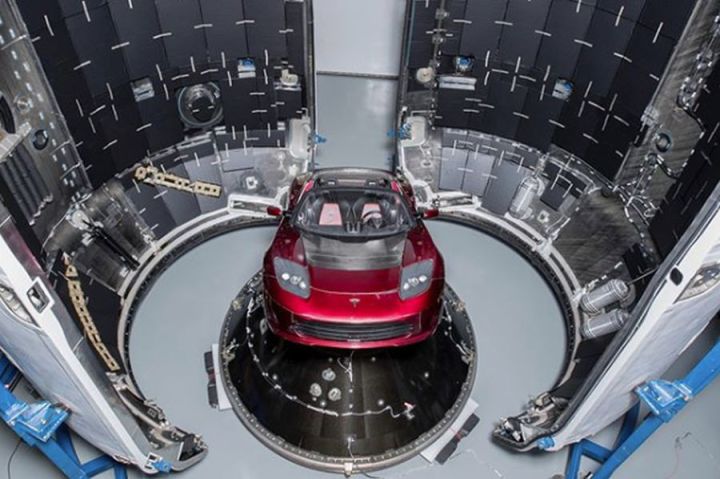
Musk tweeted that the payload for the test launch would be his own cherry-red Tesla Roadster, with its stereo blasting David Bowie’s 1969 classic Space Oddity as it leaves the launch pad. The Falcon-Tesla-Bowie combo will head for a Mars orbit, where it could remain for a billion years, according to Musk … with one small caveat: “If it doesn’t blow up on ascent.”
Although some people claimed it was all a hoax, Elon Musk once again proved his naysayers wrong by posting a series of photos to his Instagram account showing his Tesla Roadster being prepared for its journey through the vast reaches of space. As GeekWire notes, once the red Roadster is deployed from the Falcon Heavy’s payload shroud, it will enter into a “Holman transfer orbit,” traveling out as far as Mars and back but requiring no extra propulsion or guidance.
“I love the thought of a car drifting apparently endlessly through space and perhaps being discovered by an alien race millions of years in the future,” Musk tweeted. In addition to the Bowie soundtrack, the Roadster will also contain a copy of Isaac Asimov’s Foundation trilogy miniaturized on a data crystal. No word yet on whether a wheel of cheese will also make the journey.
The Falcon Heavy is scheduled for its big launch with a test-fire from Cape Canaveral in December, from the same launch pad that sent the Apollo 11 astronauts to the moon in 1969.
Falcon Heavy at the Cape pic.twitter.com/hizfDVsU7X
— Elon Musk (@elonmusk) December 20, 2017
SpaceX earlier posted an animation detailing the capabilities of the huge new booster, which Musk boasts has twice the thrust of the next largest rocket. The Falcon is a behemoth, with three boosters, each containing nine engines, that delivers five million pounds of thrust. Its payload capacity is massive as well at 119,000 pounds, the equivalent of a fully loaded 737 jetliner.
The Falcon Heavy is also designed to be reusable. After the two side boosters detach from the main module, they will fly back to Earth and land upright on a landing pad. The core booster will make a similar landing, with the second stage engines powering the spacecraft on to the red planet.
According to Space Flight Now, the Falcon Heavy still has to pass some major hurdles before Musk’s planned Ziggy Stardust stunt in January, however. Once the rocket is assembled and rolled out to Pad 38A, it will have to undergo a “static fire” test before getting a final “go” for launch. The test will be the first time SpaceX has fired 27 of the Merlin 1D engines at the same time.
If all goes well, Musk’s little red Roadster will soon be sent soaring into the cosmos, forever enshrined in orbit around Mars. Can you hear me, Major Tom?
Update: Added more launch details and Tesla photos.
Editors' Recommendations
- Elon Musk throws some light on his very busy schedule
- Elon Musk predicts date for first crewed landing on Mars
- How to watch Elon Musk’s Starship update today
- Elon Musk asked to pay $50K to end Twitter bot that tracks his jet
- Elon Musk shares aerial view of SpaceX rocket catcher

